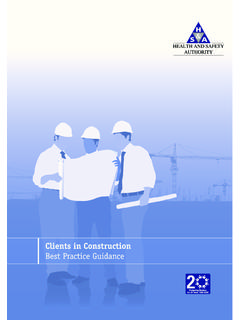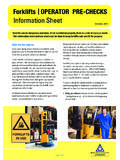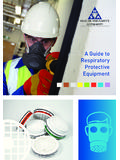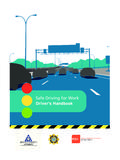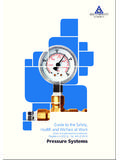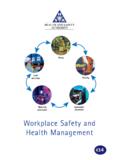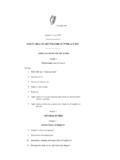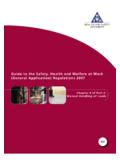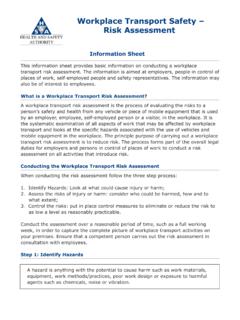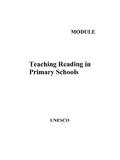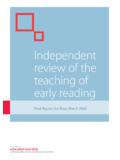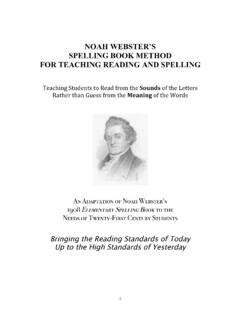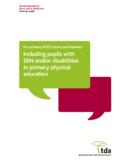Transcription of Part 1 - Health and Safety Authority
1 Guidelines on Managing Safety and Healthin Post- primary SchoolsPart 1forewordforewordThe publication of the Guidelines on Managing Safety and Health in Post- primary Schools is the outcome of a joint project undertaken by the Department of Education and Skills, the Health and Safety Authority , the State Claims Agency and the school Development Planning Initiative. These Guidelines have been developed in response to a strong demand from the education sector for guidance and clarification in relation to the legal obligations and responsibilities that have been placed on schools. This demand combined with the recognition that workplace Safety and Health needs to be managed and can be integrated into existing planning processes at school level, was at the core of the collaboration between the partners involved. The Guidelines are a management tool intended to offer guidance and practical advice to assist schools in planning, organising and managing a safe and healthy school environment for staff, pupils and visitors.
2 They will also help schools to benchmark current policies and practices against current legislative requirements. They do not place any additional responsibility on schools that does not already exist in 1 of the Guidelines is a step-by step approach to putting in place a Safety and Health management system for post- primary schools. part 2 contains all the tools and templates needed to put these systems in place. Central to the toolkit is a series of risk assessment templates which will greatly assist in carrying out the task of reducing risk in your school in a very real and practical way. Managing Safety and Health effectively in schools brings with it huge benefits. When good systems are in place to prevent accidents, injury and ill- Health to staff, pupils and visitors at a school , the whole school becomes a better place in which to work and learn. We wish to express our gratitude to all who participated in the preparation of the Guidelines.
3 We especially wish to thank the representatives of the education partners whose work greatly contributed to the success of the collaborative process involved in developing these Guidelines. We would also like to thank the group of schools which helped to pilot the Guidelines and offered invaluable feedback in developing McManusSecretary GeneralDepartment ofEducation and SkillsCiar n BreenDirectorState Claims AgencyDr. Sin ad BreathnachNational CoordinatorSchool Development Planning InitiativeMartin O HalloranChief Executive OfficerHealth and SafetyAuthorityIntroductionWho should read these Guidelines?Essential TermsWhy manage Safety and Health ?Who is responsible for Safety and Health in schools?Employees/staff duties while at workManaging Safety and Health in schoolsWhat is a Safety and Health management system?Step 1: Policy and commitment Step 2: Planning Establish an effective Safety and Health management structure Review existing documentation and systemsStep 3: Implementation Preparing the Safety statement Safety and Health policy school profile Resources for Safety and Health in the school Roles and responsibilities for Safety and Health Risk assessment Emergency procedures, fire Safety , first-aid, accidents and dangerous occurrences Instruction, training and supervision Communication and consultationStep 4: Measuring performance Step 5.
4 Audit and reviewFrequently Asked Questions (FAQs)LegislationSafety and Health management systemPlanningRoles and responsibilitiesSafety statement and risk assessmentAccident investigation and reportingFurther information and support Glossary Reference Sources and Guidance Material contents67789101314151617192021222222222 6283131333537384041424449525561 Who should read these Guidelines?Essential TermsWhy manage Safety and Health ?Who is responsible for Safety and Health in schools?Employees/staff duties while at work The Guidelines on Managing Safety and Health in Post- primary Schools (the Guidelines) is both a guidance document and a toolkit to assist schools in managing Safety , Health and resource is a step-by-step guide to help schools plan, organise and manage a safe and healthy school environment for staff, pupils and visitors. The Guidelines may be used to improve rather than replace current systems in post- primary schools. Schools may choose to use existing committees and current Safety policies and procedures and should use the Guidelines as an aid to upgrading their procedures and systems where Guidelines do NOT place any additional responsibilities on schools that are not already in Guidelines contain risk assessment templates.
5 These templates will help you address the main hazards in your school ; however, you should be aware there may be other hazards particular to your school that are not dealt with in this Guidelines have been prepared by a working group comprised of representatives of the Department of Education and Skills, the Health and Safety Authority , the State Claims Agency and the school Development Planning Guidelines allow school planning for Safety and Health to be integrated into the Whole school Planning process, which is familiar to Guidelines on Managing Safety and Health in Post- primary Schools aim to: assist schools to plan, organise and manage Safety and Health effectively; help schools to benchmark current policies and practices against current legislative requirements, common law duty of care and best practice; reduce the administrative burden on schools; enable schools to write or update their Safety statements; enable schools to create or update their risk assessments; facilitate school management and staff in implementing and reviewing best practice in Safety and should read these Guidelines?
6 These Guidelines should be read by Boards of Management/VECs, school managers, Principals, Deputy Principals, relevant post holders, teaching and non-teaching staff. Everybody in the school community should have access to the TermsA complete glossary is included on page 55 of the Guidelines. From the outset, all members of the school community should be familiar with the following essential terms:Employees/staff:For ease of reading the term employee(s) has been replaced with the word staff in many instances. Where employee(s) is mentioned the reader can interpret this to mean staff . The definition of employee is outined in Section 2(1) of the Safety Health and Welfare at Work Act :A hazard is anything that has the potential to cause harm to people, property or the environment. It can be a work material, a piece of equipment or a work method or :Risk is the likelihood that someone will be harmed by the hazard together with the severity of harm suffered.
7 Risk also depends on the number of people exposed to the measures:Controls/control measures are the precautions taken to ensure that the risk is eliminated or assessment:A risk assessment is concerned with identifying the hazard, then estimating the severity and likelihood of harm arising from such a hazard. The employer can then put in place control measures to minimise the risk or weigh up whether he or she has taken enough precautions to prevent and Health policy:Every Safety statement begins with a declaration, signed at senior management level on the employer s behalf. This is known as the Safety and Health policy. The declaration gives a commitment to ensuring that a workplace is as safe and healthy as reasonably practicable and that all statutory requirements will be complied with. This declaration should spell out the policy in relation to overall Safety and Health performance, provide a framework for managing Safety and Health and list relevant objectives.
8 A copy of the Safety and Health policy can be displayed in a public area of the school where it is visible to and Health management system:This refers to that part of the overall management system of the school that includes the organisational structure, planning activities, responsibilities, practices, procedures and resources for developing, implementing, reviewing and maintaining the school s Safety and Health statement:A Safety statement is a written programme of the school s commitment to safeguard the Safety , Health and welfare of staff (teaching and non-teaching) while they work and the Safety and Health of other people who might be affected by work activities in the school including visitors, parents/guardians and pupils. In essence, the Safety statement details how the Safety , Health and welfare of staff, pupils, visitors and contractors are managed by the school . The Safety statement must include a comprehensive risk assessment which identifies hazards in the workplace, assesses the risks presented by these hazards and details what control measures should be put in place to eliminate/reduce the Terms cont proactive Safety and Health management system promotes a safer working environment and results in the avoidance of accidents and incidents.
9 In addition to reducing costs, an effective Safety and Health management system ensures that:Why manage Safety and Health ? good Safety and Health arrangements are in place for staff, pupils and anyone affected by the work activities of the school ; teachers and other staff are confident that well- planned Safety and Health systems are in place when carrying out their responsibilities; resources are not wasted - financial priorities can be related to careful risk assessments; staff absences due to injuries or occupational ill- Health are reduced; the number of accidents and associated costs are reduced; morale is improved in the school for pupils, staff and parents/guardians; the number and cost of compensation claims are are moral, legal and ethical reasons for managing Safety and Health at work. Hazards and risks are present in schools, just as in any other workplace. However, schools are a unique environment as the workplace is shared with many more non-workers than workers, pupils.
10 Workplace accidents and incidents cause pain and suffering to the individual and his/her family. They affect people s ability to work and their enjoyment of life outside work. Many accidents and cases of occupational ill- Health at work are due to a failure to manage Safety cost of occupational accidents can be high and can result in associated costs to employers such as: management time spent dealing with accidents; increased insurance premiums and legal costs; compensation claims. sick pay, temporary replacement labour, early retirement, recruiting new labour and retraining; repair of damage to plant, equipment, materials and products;8 Who is responsible for Safety and Health in schools?In Ireland, the Board of Management of a school and in the case of a VEC school , the Vocational Education Committee, being the employer, are responsible for ensuring as far as reasonably practicable, the Safety and Health at work of their employees and the Safety and Health of those who are in any way affected by the work activities of the school .
